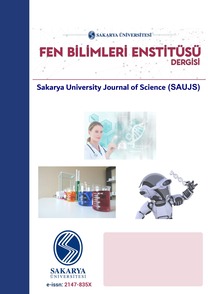Structural, Microstructural and Electrochemical Characterization of Ni-YSZ Anodes Fabricated from Pechini-Derived Composite Powders
Structural, Microstructural and Electrochemical Characterization of Ni-YSZ Anodes Fabricated from Pechini-Derived Composite Powders
The most widely used solid oxide fuel cell (SOFC) anodes, nickel-yttria stabilized zirconia (NiO-YSZ) composites, are generally fabricated by co-sintering of NiO and YSZ powders. In this study, to achieve a longer triple phase boundary length, these composites were fabricated from powders synthesized via an ethylene glycol-based Pechini method. Polymeric precursors of NiO and YSZ were prepared separately and then mixed, dried and calcined 600, 700 and 800°C for 4 hours, in air. NiO and YSZ crystals with average sizes of 26 and 7 nm, respectively were achieved upon calcination at 600 °C. With increasing heat treatment temperature, both the crystal and agglomerate sizes increased, which, in turn, an increased the anode polarization resistances. Electrochemical activities comparable to or higher than anode prepared by cosintering of powder mixtures were achieved in the anodes prepared by sintering of the composite powders.Keywords: Solid oxide fuel cells, polymeric precursor, NiO-YSZ, Pechini method
___
- [1] A.H. Karim, K.-Y. Park, T.H. Lee, S.A. Muhammed Ali, S. Hossain, H.Q.H.H. Absah, J.-Y. Park, A.K. Azad, “Synthesis, structure and electrochemical performance of double perovskite oxide Sr2Fe1-xTixNbO6-δ as SOFC electrode,” Journal of Alloys and Compounds, vol. 724, pp. 666-673, 2017.
- [2] S.C. Singhal, K. Kendall, “High temperature solid oxide fuel cells: fundamentals, design, and applications” Elsevier Science Ltd, ISBN 1-85617-387- 9, Oxford, UK, 2003.
- [3] S.Tao, J. T. S. Irvine, “A redox-stable efficient anode for solid-oxide fuel cells,” Nature Materials, 2(5), 320–323, 2003.
- [4] A. Sarikaya, V. Petrovsky, F. Dogan, “Effect of the anode microstructure on the enhanced performance of solid oxide fuel cells,” International Journal Hydrogen Energy, vol. 37, pp. 11370-11377, 2012.
- [5] B. S. Prakash, S. S. Kumar, S.T. Aruna, “Properties and Development of Ni/YSZ as an anode material in solid oxide fuel cell: A review”, Renewable and Sustainable Energy Reviews 36, 149-179, 2014.
- [6] J. Mizusaki, H. Tagawa, T. Saito, T. Yamamura, “Kinetic studies of the reaction at the nickel pattern electrode on YSZ in H2–H2O atmospheres,” Solid State Ionics, vol. 70/71, pp. 52–58, 1994.
- [7] T. Klemenso, K. Thyden, M. Chen, H.-J. Wang, “Stability of Ni-yttria stabilized zirconia anodes based on Niimpregnation,” Journal of Power Sources, vol. 195, no 21, pp. 7295-7301, 2010.
- [8] A. Buyukaksoy, S.P. Kammampata, V. I. Birss, “Effect of porous YSZ scaffold microstructure on the long-term performance of infiltrated Ni-YSZ anodes,” Journal of Power Sources, vol. 287, pp 349-358, 2015.
- [9] P. Tiwari, S. Basu, “Ni infiltrated YSZ anode stabilization by inducing strong metal support interaction between nickel and titania in solid oxide fuel cell under accelerated testing,” International Journal of Hydrogen Energy, vol. 38, no. 22, 9494-9499, 2013.
- [10] K.R. Han, Y. Jeong, H. Lee, C.-S. Kim, “Fabrication of NiO/YSZ anode material for SOFC via mixed NiO precursors,” Materials Letters, vol. 61, pp. 1242-1245, 2007.
- [11] H. Mohebbi, T. Ebadzadeh, F.A. Hesari, “Synthesis of nano-crystalline (Ni/NiO)– YSZ by microwave-assisted combustion synthesis method: The influence of pH of precursor solution, Journal of Power Sources, vol. 178, pp. 64-68, 2008.
- [12] P.G. Keech, D.E. Trifan, V.I. Birss, “Synthesis and Performance of Sol-Gel Prepared Ni-YSZ Cermet SOFC Anodes,” Journal of The Electrochemical Society, vol. 152, no. 3, pp. A645-A651, 2005.
- [13] C.M. Grgicak, R.G. Green, W.-F. Du, J.B. Giorgi, “Synthesis and Characterization of NiO–YSZ Anode Materials: Precipitation, Calcination, and the Effects on Sintering,” Journal of American Ceramic Society, vol. 88, no. 11, pp. 3081-3087, 2005.
- [14] S. Li, R. Guo, J. Li, Y. Chen, W. Liu, “Synthesis of NiO–ZrO2 powders for solid oxide fuel cells,” Ceramics International, vol. 29, pp. 883-886, 2003.
- [15] A. Ringuede, D. Bronine, J.R. Frade, “Assessment of Ni/YSZ anodes prepared by combustion synthesis,” Solid State Ionics, vol. 146, pp. 219-224, 2002.
- [16] T. Razpotnik, J. Macek, “Synthesis of nickel oxide/zirconia powders via a modified Pechini method,” Journal of European Ceramic Society, vol. 27, pp. 1405-1410, 2007.
- [17] H.P. Dasari, S.-Y. Park, J. Kim, J.-H. Lee, B.-K. Kim, H.-J. Je, H.-W. Lee, K. J. Yoon, “Electrochemical characterization of Ni-yttria stabilized zirconia electrode for hydrogen production in solid oxide electrolysis cells,” Journal of Power Sources, vol. 240, pp. 721-728, 2013.
- [18] S. Dierickx, J. Joos, A. Weber, E. IversTiffée, “Advanced impedance modelling of Ni/8YSZ cermet anodes,” Electrochimica Acta, vol. 265, pp. 736- 750, 2018.
- [19] A. Buyukaksoy, V.I. Birss, “Comparison of the Electrochemistry of Ni Thin Film and Ni-YSZ Composite Anodes Fabricated by Polymeric Precursor Deposition,” Journal of The Electrochemical Society, vol. 163, no. 13, pp. F1350-F1357, 2016.
- [20] V. Sonn, A. Leonide, and E. Ivers-Tiffée, “Combined deconvolution and CNLS fitting approach applied on the impedance response of technical Ni8YSZ cermet electrodes,” Journal of the Electrochemical Society, vol.155, no. 7, pp. B675-B679, 2008.
- ISSN: 1301-4048
- Yayın Aralığı: Yılda 6 Sayı
- Başlangıç: 1997
- Yayıncı: Sakarya Üniversitesi Fen Bilimleri Enstitüsü
Sayıdaki Diğer Makaleler
Deep Learning Based Automatic Speech Recognition for Turkish
Prioritizing the Factors for Customer-Oriented New Product Design in Industry 4.0
Melike ERDOĞAN, Özge Nalan BİLİŞİK
1Non-Markovian Corrections to Quantum Regression Theorem for the Strong Coupling Spin-Boson Model
Mehmet Kürşat YALÇIN, İlyas KACAR, Halil Bahadır AKYILDIZ
Aligül BÜYÜKAKSOY, Buse BİLBEY, Gamze EROL
